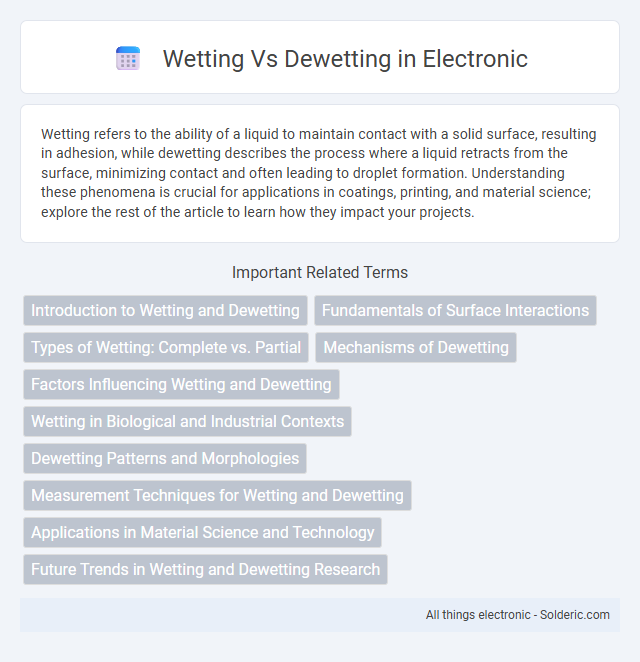Wetting refers to the ability of a liquid to maintain contact with a solid surface, resulting in adhesion, while dewetting describes the process where a liquid retracts from the surface, minimizing contact and often leading to droplet formation. Understanding these phenomena is crucial for applications in coatings, printing, and material science; explore the rest of the article to learn how they impact your projects.
Comparison Table
| Aspect | Wetting | Dewetting |
|---|---|---|
| Definition | Process where a liquid spreads over a solid surface | Process where a liquid retracts from a solid surface |
| Contact Angle | Less than 90deg (indicates good wetting) | Greater than 90deg (indicates poor wetting) |
| Surface Energy | High solid surface energy promotes wetting | Low solid surface energy promotes dewetting |
| Examples | Water on clean glass, ink on paper | Water on waxed surface, oil on polymer |
| Applications | Coatings, adhesion, printing | Self-cleaning surfaces, microfluidics |
| Thermodynamics | Minimizes surface energy by maximizing contact | Minimizes surface energy by minimizing contact |
Introduction to Wetting and Dewetting
Wetting describes the process where a liquid spreads across or adheres to a solid surface due to intermolecular forces, influenced by surface tension and contact angle. Dewetting occurs when a liquid retracts or forms droplets on a surface, often driven by surface energy minimization and substrate heterogeneity. Understanding wetting and dewetting dynamics is crucial in applications such as coating technologies, microfluidics, and material science.
Fundamentals of Surface Interactions
Wetting and dewetting describe how liquids interact with solid surfaces, governed primarily by surface tension, adhesion, and cohesion forces. The contact angle quantifies these interactions, where low angles indicate strong wetting and high angles signify dewetting tendencies. Understanding these phenomena is crucial for optimizing processes like coating, printing, and microfluidics by controlling surface energies and treatment methods that influence Your material interfaces.
Types of Wetting: Complete vs. Partial
Complete wetting occurs when a liquid spreads fully across a solid surface, forming a contact angle close to 0 degrees, indicating strong adhesive forces between the liquid and solid. Partial wetting is characterized by a finite contact angle between 0 and 180 degrees, where the liquid forms droplets due to a balance between cohesive forces within the liquid and adhesive forces to the surface. These wetting behaviors are quantified by Young's equation, which relates surface tensions of the solid, liquid, and vapor phases.
Mechanisms of Dewetting
Dewetting occurs when a liquid film retracts from a solid surface due to unfavorable surface energy interactions, primarily driven by the imbalance between adhesive forces (liquid-solid) and cohesive forces (liquid-liquid). Mechanisms of dewetting include nucleation and growth of dry patches, spinodal dewetting related to surface tension instabilities, and contact line retraction influenced by surface heterogeneities. These processes are governed by parameters such as surface tension, viscosity, substrate wettability, and temperature, critically affecting thin film stability on substrates.
Factors Influencing Wetting and Dewetting
Surface energy, roughness, and chemical composition critically influence wetting and dewetting behaviors on solid substrates. High surface energy materials promote wetting by lowering the contact angle, while low surface energy surfaces favor dewetting, causing liquid droplets to bead up. Environmental factors such as temperature, humidity, and the presence of contaminants also significantly impact the dynamic balance between wetting and dewetting processes.
Wetting in Biological and Industrial Contexts
Wetting in biological contexts involves the interaction of liquids with cell membranes, tissues, and biofilms, influencing processes such as drug delivery, wound healing, and microbial adhesion. In industrial settings, wetting governs coating technologies, lubrication efficiency, and the performance of adhesives, where the contact angle and surface energy dictate liquid spreading on different substrates. Understanding wetting dynamics enables optimization of surface treatments, enhancing material compatibility and functionality across biomedical devices and manufacturing processes.
Dewetting Patterns and Morphologies
Dewetting patterns and morphologies arise from the instability of thin liquid films on solid substrates, leading to distinct structures such as holes, rims, and droplets. These patterns are influenced by factors including surface tension, intermolecular forces, substrate heterogeneity, and film thickness, which dictate the nucleation and growth of dry patches. Analysis of dewetting morphologies provides critical insights for applications in coatings, microfabrication, and biomaterials by controlling wettability and film stability.
Measurement Techniques for Wetting and Dewetting
Measurement techniques for wetting and dewetting primarily involve contact angle goniometry, where the contact angle formed by a liquid droplet on a solid surface quantifies wettability. Techniques like sessile drop, pendant drop, and captive bubble methods provide precise measurements of advancing and receding contact angles, critical for understanding dynamic wetting behavior. High-speed imaging and surface energy analysis complement these methods to capture transient dewetting phenomena and interfacial interactions at the micro and nanoscale.
Applications in Material Science and Technology
Wetting and dewetting processes play a crucial role in material science and technology by influencing surface coatings, adhesion, and thin-film fabrication. Control over wetting properties enables the design of hydrophobic or hydrophilic surfaces, essential for applications such as self-cleaning materials, anti-fogging coatings, and printed electronics. You can optimize device performance and durability by tailoring these interactions at the micro- and nanoscale for advanced sensors, microfluidic devices, and flexible electronics.
Future Trends in Wetting and Dewetting Research
Future trends in wetting and dewetting research emphasize the development of smart surfaces with tunable wettability for applications in microfluidics, biotechnology, and energy harvesting. Advances in nanotechnology and materials science enable precise control over surface morphology and chemistry, facilitating dynamic wettability switching and anti-fouling properties. Computational modeling and machine learning are increasingly integrated to predict wetting behaviors and design innovative surfaces with enhanced performance and multifunctionality.
Wetting vs dewetting Infographic

 solderic.com
solderic.com